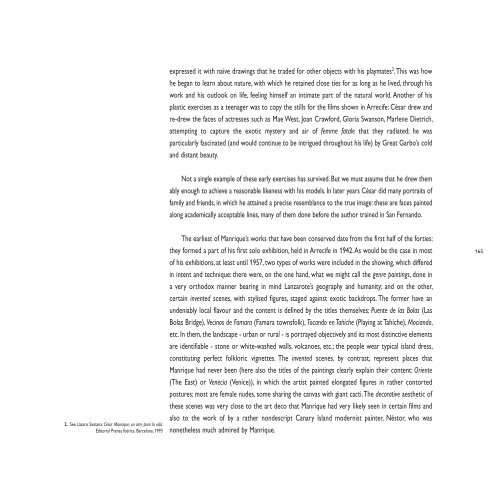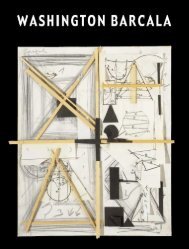VERSIÓN INGLESA ENGLISH VERSION - Fundación César Manrique
VERSIÓN INGLESA ENGLISH VERSION - Fundación César Manrique
VERSIÓN INGLESA ENGLISH VERSION - Fundación César Manrique
Create successful ePaper yourself
Turn your PDF publications into a flip-book with our unique Google optimized e-Paper software.
2. See Lázaro Santana: <strong>César</strong> <strong>Manrique</strong>, un arte para la vida.<br />
Editorial Prensa Ibérica. Barcelona, 1993<br />
expressed it with naive drawings that he traded for other objects with his playmates 2 . This was how<br />
he began to learn about nature, with which he retained close ties for as long as he lived, through his<br />
work and his outlook on life, feeling himself an intimate part of the natural world. Another of his<br />
plastic exercises as a teenager was to copy the stills for the films shown in Arrecife: <strong>César</strong> drew and<br />
re-drew the faces of actresses such as Mae West, Joan Crawford, Gloria Swanson, Marlene Dietrich,<br />
attempting to capture the exotic mystery and air of femme fatale that they radiated; he was<br />
particularly fascinated (and would continue to be intrigued throughout his life) by Great Garbo’s cold<br />
and distant beauty.<br />
Not a single example of these early exercises has survived. But we must assume that he drew them<br />
ably enough to achieve a reasonable likeness with his models. In later years <strong>César</strong> did many portraits of<br />
family and friends, in which he attained a precise resemblance to the true image: these are faces painted<br />
along academically acceptable lines, many of them done before the author trained in San Fernando.<br />
The earliest of <strong>Manrique</strong>’s works that have been conserved date from the first half of the forties:<br />
they formed a part of his first solo exhibition, held in Arrecife in 1942. As would be the case in most<br />
of his exhibitions, at least until 1957, two types of works were included in the showing, which differed<br />
in intent and technique: there were, on the one hand, what we might call the genre paintings, done in<br />
a very orthodox manner bearing in mind Lanzarote’s geography and humanity; and on the other,<br />
certain invented scenes, with stylised figures, staged against exotic backdrops. The former have an<br />
undeniably local flavour and the content is defined by the titles themselves: Puente de las Bolas (Las<br />
Bolas Bridge), Vecinos de Famara (Famara townsfolk), Tocando en Tahíche (Playing at Tahíche), Mociando,<br />
etc. In them, the landscape - urban or rural - is portrayed objectively and its most distinctive elements<br />
are identifiable - stone or white-washed walls, volcanoes, etc.; the people wear typical island dress,<br />
constituting perfect folkloric vignettes. The invented scenes, by contrast, represent places that<br />
<strong>Manrique</strong> had never been (here also the titles of the paintings clearly explain their content: Oriente<br />
(The East) or Venecia (Venice)), in which the artist painted elongated figures in rather contorted<br />
postures; most are female nudes, some sharing the canvas with giant cacti. The decorative aesthetic of<br />
these scenes was very close to the art deco that <strong>Manrique</strong> had very likely seen in certain films and<br />
also to the work of by a rather nondescript Canary Island modernist painter, Néstor, who was<br />
nonetheless much admired by <strong>Manrique</strong>.<br />
165
















![Becas y premios de la Fundación César Manrique [1997-2006]](https://img.yumpu.com/20766851/1/184x260/becas-y-premios-de-la-fundacion-cesar-manrique-1997-2006.jpg?quality=85)
